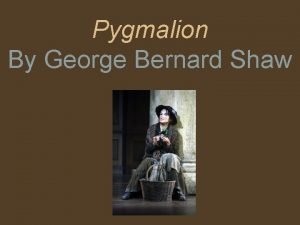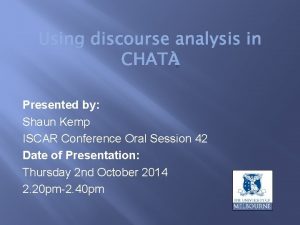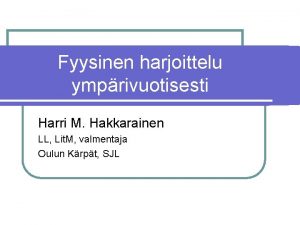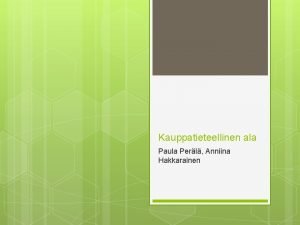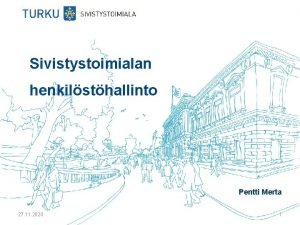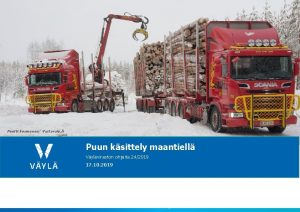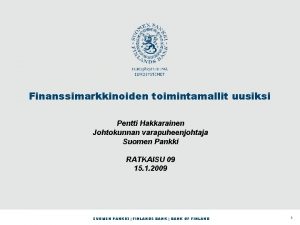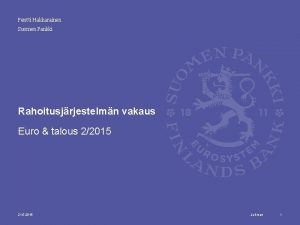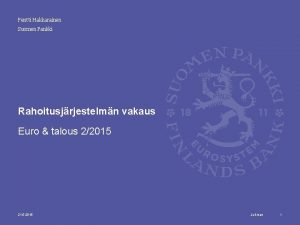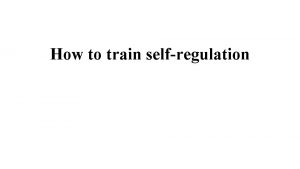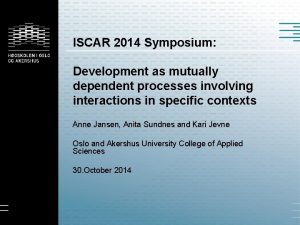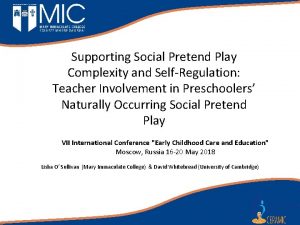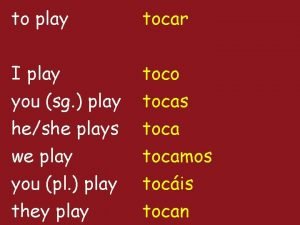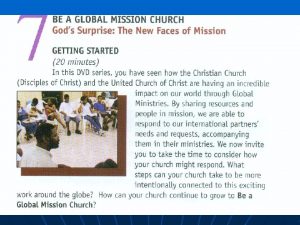Development of selfregulation in play Pentti Hakkarainen ISCAR











- Slides: 11

Development of self-regulation in play Pentti Hakkarainen ISCAR, 30 September, 2014

Research background • This research is a part of the project “Development of Self-regulation in Play”, which is carried out at the Research Laboratory of Play in Lithuanian University of Educational Sciences, Vilnius. • This study is founded by a grant (No. VP-3. 1 -ŠMM 07 -K-02 -066) from the Research Council of Lithuania. ISCAR, 30 September, 2014

Historical changes • Children’s life filled with screen media; less time and opportunities for make-believe play (USA – screen time starts at 5 months vs. 5 years in the 70’s) • ‘Gamefication’ of childhood: play time is filled with commercial, adult designed content in game format (Success is evaluated how the content sells. E. g. ‘Angry birds’ is transformed to play based learning tool, which is exported to several countries) • How ‘game frame’ changes development of self-regulation in play? • Emphasis on immediate affective reaction and inhibitory control level? (Confiscating all electronic media from children during summer camp launched child initiated make-believe ISCAR, 30 September, 2014 play in Finland!)

Premises of self-regulation (Vygotsky) • The role of mediation and external regulation in the development of the basis of self-regulation (Others regulate me; I regulate others; genetic law: from inter- to intra-) • Self-regulation is mastered first in role position and later in personal position outside play context (Empirical evidence: transitions personal position – role position – personal position Strelkova 1986) • Verbal development (in play) offers new psychological tools of self-regulation (e. g. private speech creates the capacity verbally mediate child’s motivation, thoughts and actions) • The levels of self-regulation from inhibitory control to motivational constructs; the role of anticipation in selfregulation • Self-regulation is an organic union of affective and intellectual ISCAR, 30 September, 2014 development

Developmental mechanism of selfregulation in play? • Emotion-regulation function of play (Freud and Piaget) • Exploration of potential roles (Erikson) • Separation of ideas from reality (sense-making/ cultural meaning; sense field/ visual field makes pretending possible); subordination to social rules in overcoming situational action impulses (Vygotsky) • Two positions: personal actions and role actions as the criterion of pretend play (Kravtsova) • Two positions in adult play interventions through role (Bredikyte) • Children’s joint construction of role positions (Goncu& Gaskins) • Two dimensions of play construction and contradictions in preschool institutions (Hakkarainen) ISCAR, 30 September, 2014

Play age development (Vygotsky) Crisis at 3 • New selfawareness and relation to self • Intellectualize d perception Lytic playage • Contrapositio ning real and ideal • Role position vs. real position ISCAR, 30 September, 2014 Crisis at 7 • New selfawareness and relation to self • Intellectualize d emotions

Levels of other – self regulation in play • Personal action vs. role actions of an individual child – testing understanding of a role position and relating to self position = dual subject of play • Children’s joint construction of several role positions – mutuality testing of several role positions; acceptance using improvisation rule ‘yes – and then’ • Construction of narrative plot with ideal forms through adult participation – play plot is elaborated by adults for attaining defined educational goals (adult roles are constructed for demonstrating ideal forms of behavior)ISCAR, 30 September, 2014

Play motivation • Ideal and real forms of cultural activities and actions • Ideal forms are accepted and supported in a culture • Special form of causality – invitation to be adopted, but children’s own initiative is necessary • Presented in tales, stories and narratives of daily life • Sense making dominates and transforms objective meanings • What is the object of play? Play as a type of activity cannot be defined without indicating object – motives • From interpsychic to intrapsychic: How relations are indicated between. ISCAR, participants? 30 September, 2014

The case of ‘Troll Mirkku’ • Constructing ‘key experience’ in play intervention • Designing adult intervention (teacher in role) to children’s troll play world: the teacher imitated the behavior of hyper active boys of the group (vertically integrated 4 – 8 years) • Adult question: What shall we do if terrible ‘Mirkku’ visits us again? Write down the rules of our play world and give to her • The change of self - control: children’s ‘new’ rules were the same as those on the wall (which were indicated to ‘Mirkku’ during her visit), but only the new ones were followed in practice • ‘Village’ meeting: what to do with the troll (one of hyper active boys) who broke the rules = new rules are real tools of control ISCAR, 30 September, 2014

Treasure of Pharaoh Enakhton • Time travel to ancient Egypt and visit to the tomb of Enakhton (coming through dark emergency exit to the back stage of the school) where a guard waits for children • The guard tells children that they may open one of four chests if all are unanimous (There are four drawers on wheels under the stage). Children select the chest of Wisdom. • Inside they find a smaller chest locked with several keys (children have found the keys during their six month’s adventure). Keys open the locks, but the content is divided into two halves: sweets and jewels; a box containing the seed of the tree of wisdom • The seed is selected and after returning back to the classroom ISCAR, 30 September, 2014 it was sowed

Publications and contact • Hakkarainen, P. (2009) Development of motivation in play and narratives In Sean Blenkinshop (ed. ) The imagination in education. Extending the boundaries of theory and practice pp. 64 – 78. Newcastle Upon Tyne: Cambridge Scholars Publishing • Hakkarainen, P. & Bredikyte, M. (2014) Introduction to developmental play pedagogy (In Finnish) • Hakkarainen, P. & Bredikyte, M. (in print) How play creates the zones of proximal development. The Routledge International Handbook of Young Children's Thinking and Understanding • phakkar@gmail. com or pentti. hakkarainen@leu. lt ISCAR, 30 September, 2014


